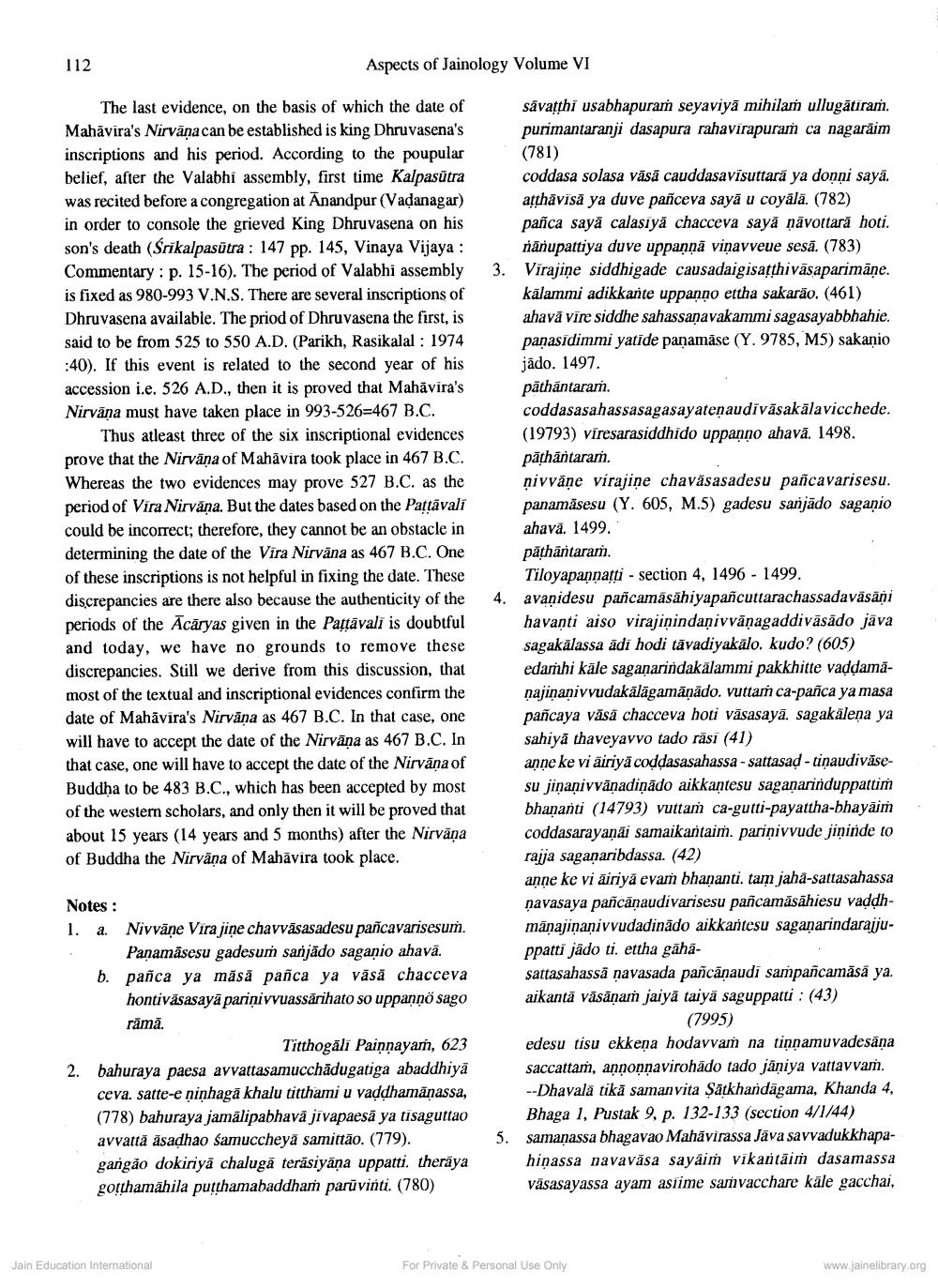Book Title: Reconsidering the date of Nirvna of Lord Mahavira Author(s): Sagarmal Jain Publisher: Z_Shwetambar_Sthanakvasi_Jain_Sabha_Hirak_Jayanti_Granth_012052.pdf View full book textPage 7
________________ 112 Aspects of Jainology Volume VI The last evidence, on the basis of which the date of Mahāvira's Nirvāna can be established is king Dhruvasena's inscriptions and his period. According to the poupular belief, after the Valabhi assembly, first time Kalpasūtra was recited before a congregation at Anandpur (Vadanagar) in order to console the grieved King Dhruvasena on his son's death (Srikalpasūtra : 147 pp. 145, Vinaya Vijaya : Commentary : p. 15-16). The period of Valabhi assembly is fixed as 980-993 V.N.S. There are several inscriptions of Dhruvasena available. The priod of Dhruvasena the first, is said to be from 525 to 550 A.D. (Parikh, Rasikalal : 1974 :40). If this event is related to the second year of his accession i.e. 526 A.D., then it is proved that Mahāvīra's Nirvāna must have taken place in 993-526=467 B.C. Thus atleast three of the six inscriptional evidences prove that the Nirvāņa of Mahāvira took place in 467 B.C. Whereas the two evidences may prove 527 B.C. as the period of Vira Nirvāna. But the dates based on the Pattavali could be incorrect; therefore, they cannot be an obstacle in determining the date of the Vira Nirvana as 467 B.C. One of these inscriptions is not helpful in fixing the date. These discrepancies are there also because the authenticity of the periods of the Ācāryas given in the Pattävali is doubtful and today, we have no grounds to remove these discrepancies. Still we derive from this discussion, that most of the textual and inscriptional evidences confirm the date of Mahāvira's Nirvana as 467 B.C. In that case, one will have to accept the date of the Nirvana as 467 B.C. In that case, one will have to accept the date of the Nirvana of Buddha to be 483 B.C., which has been accepted by most of the western scholars, and only then it will be proved that about 15 years (14 years and 5 months) after the Nirvana of Buddha the Nirvāna of Mahāvira took place. savathi usabhapuram seyaviyā mihilam ullugatiram. purimantaranji dasapura rahavirapuram ca nagaraim (781) coddasa solasa vāsā cauddasavïsuttara ya donni saya. atthāvisā ya duve pañceva sayā u coyala. (782) panca saya calasiya chacceva sayā nāvottară hoti. nānupattiya duve uppanna vinavveue sesä. (783) 3. Virajine siddhigade causadaigisatthivāsaparimāņe. kālammi adikkante uppanno ettha sakarão. (461) ahavā vire siddhe sahassanavakammi sagasayabbhahie. panasidimmi yatīde panamāse (Y. 9785, M5) sakanio jādo. 1497. pāthāntaram. coddasasahassasagasayatenaudivāsakālavicchede. (19793) víresarasiddhido uppanno ahavā. 1498. pāthāntaram. nivvāne virajine chaväsasadesu pañcavarisesu. panamāsesu (Y. 605, M.5) gadesu sanjādo saganio ahavä. 1499. pāthārtaram. Tiloyapannatti - section 4, 1496 - 1499. 4. avanidesu pañcamāsähiyapañcuttarachassadaväsäni havanti aiso virajinindanivvāņagaddivāsädo jāva sagakālassa adi hodi tăvadiyakalo. kudo? (605) edamhi käle saganarindakalammi pakkhitte vaddamanajinanivvudakālāgamānädo. vuttam ca-pañca ya masa pañcaya vāsä сhacceva hoti väsasaya, sagakälena ya sahiya thaveyavvo tado räsi (41) anne ke vi äiriyä сoddasasahassa - sattasad - tinaudivāsesu jinanivvanadiņādo aikkantesu saganarinduppattim bhananti (14793) vuttam ca-gutti-payattha-bhayāim coddasarayaņāi samaikantaim. pariņivvude jininde to rajja saganaribdassa. (42) anne ke vi äiriyā evam bhananti. tam jaha-sattasahassa navasaya pañcāņaudivarisesu pañcamāsāhiesu vaddhmānajinanivvudadinādo aikkartesu saganarindarajjuppatti jādo ti, ettha gāhāsattasahassā navasada pañcānaudi sampañcamāsa ya. aikantā vāsānam jaiyä taiyä saguppatti : (43) (1995) edesu tisu ekkeņa hodavvam na tinnamuvadesāņa saccattam, annonnavirohado tado janiya vattavvam. --Dhavalā tikā saman vita Sātkhandägama, Khanda 4, Bhaga 1, Pustak 9, p. 132-133 (section 4/1/44) 5. samanassa bhagavao Mahävirassa Jäva savvadukkhapa hiņassa navaväsa sayaiṁ vikantäim dasamassa väsasayassa ayam asiime samvacchare kale gacchai, Notes: 1. a. Nivvāne Vira jine chavväsasadesu pañcavarisesuń. Panamāsesu gadesum sarjādo saganio ahavā. b. pañca ya māsā pañca ya väsä сhacceva hontivāsasayā pariņivvuassărihato so uppanno sago rämā. Titthogäli Paiņnayam, 623 2. bahuraya paesa avvattasamucchādugatiga abaddhiya ceva. satte-e ninhaga khalu titthami u vaddhamänassa, (778) bahuraya jamälipabhavä jivapaesa ya tisaguttao avvattā asadhao samuccheyä samittão. (779). gangão dokiriyä сhaluga teräsiyāņa uppatti. theräya gotthamähila putthamabaddham parūvinti. (780) Jain Education International For Private & Personal Use Only www.jainelibrary.orgPage Navigation
1 ... 5 6 7 8
